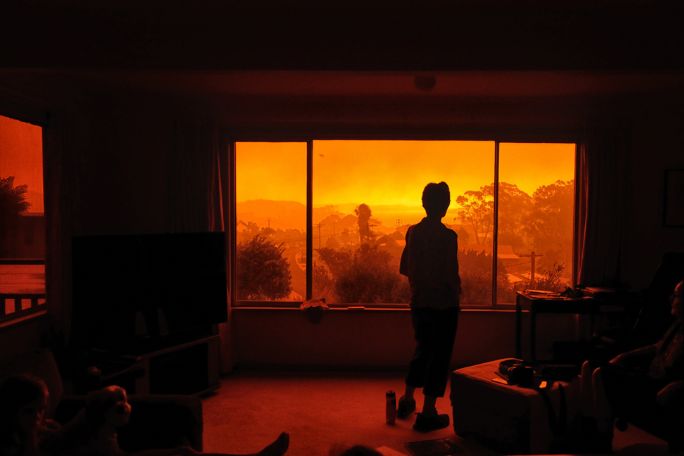Lesson summary
In this English lesson, students revise key visual techniques such as size, ratio, salience, colour and symbolism. They use these strategies to analyse the emotional impact of a variety of film stills from the feature documentary ‘A Fire Inside.’ Students then analyse the combination of stills in the form of a short film clip.
Learning intentions:
Students will...
- identify visual techniques such as size, salience, colour and symbolism
- analyse the combined effects of these visual techniques.
Success criteria:
Students can...
- know the definitions of key visual techniques such as size, salience, colour and symbolism
- identify examples of the above visual techniques and consider their impact
- write an analytical paragraph about the combined effects of visual techniques.
Lesson guides and printables
Lesson details
Curriculum mapping
Australian curriculum content descriptions:
Year 7 English:
- Compare the ways that language and images are used to create a character, and to influence emotions and opinions in different types of texts (ACELT1621)
Year 8 English:
- Interpret and analyse language choices, including sentence patterns, dialogue, imagery and other language features, in short stories, literary essays and plays (ACELT1767)
Year 9 English:
- Analyse and explain the use of symbols, icons and myth in still and moving images and how these augment meaning (ACELA1560)
- Explore and explain the combinations of language and visual choices that authors make to present information, opinions and perspectives in different texts (ACELY1745)
Year 10 English:
- Analyse and explain how text structures, language features and visual features of texts and the context in which texts are experienced may influence audience response (ACELT1641)
Syllabus outcomes: EN5-1A
General capabilities: Critical and Creative Thinking, Ethical Understanding, Information and Communication Technology (ICT) Capability, Literacy, Personal and Social Capability
Cross-curriculum priority: Sustainability
Relevant parts of Year 7 achievement standards: By the end of Year 7, students understand how text structures can influence the complexity of a text and are dependent on audience, purpose and context. They demonstrate understanding of how the choice of language features, images and vocabulary affects meaning.
Relevant parts of Year 8 achievement standards: By the end of Year 8, students understand how the selection of text structures is influenced by the selection of language mode and how this varies for different purposes and audiences. Students explain how language features, images and vocabulary are used to represent different ideas and issues in texts.
Relevant parts of Year 9 achievement standards: By the end of year 9 students evaluate and integrate ideas and information from texts to form their own interpretations. They select evidence from texts to analyse and explain how language choices and conventions are used to influence an audience. They listen for ways texts position an audience.
Relevant parts of Year 10 achievement standards: By the end of Year 10, students evaluate how text structures can be used in innovative ways by different authors. They explain how the choice of language features, images and vocabulary contributes to the development of individual style.
Resources required
- A4 copies of the selected images
- A device capable of presenting a video to the class
- PowerPoint presentation: Fire Inside: Visual Language
- Student Worksheets – one copy per student
Skills
This lesson is designed to build students’ competencies in the following skills:
- Communication
- Creativity
- Critical thinking
- Cultural understanding
- Digital literacy
- Empathy
- Ethical understanding
- Global citizenship
Additional Info
Before teaching the lessons, ensure you have watched the feature documentary ‘A Fire Inside’, rated MA15+ and have gained approval from parents and guardians before viewing the documentary.
To view the film you can rent or purchase an online copy from Google Play, Apple TV, Prime Video, or Ritz at home.
Students may develop heightened emotions and discomfort during the film whilst learning about the psychological effects and impact the fires had on animals, people, families, communities, and the country. It is recommended that you direct students to a school counsellor if they require additional support and read through the Handling Sensitive Topics and Issues: Handling Sensitive Topics and Issues.
About the feature documentary - A Fire Inside:
When a volunteer firefighter drives his car to almost certain death, he does it during the worst fires in Australian history because he ‘has a job to do’. Three months later, the fires are out, but his fight is just beginning.
Turning a sensitive lens on the unprecedented devastation of Australia’s 2019/2020 ‘Black Summer’ bushfires; from a country-wide emergency to the astonishing stories of help that emerged, A Fire Inside presents an inspirational look at how people respond to crisis and the impact it has on the human spirit.


Welcome back!
Don't have an account yet?
Log in with:
By signing up to Cool.org you consent and agree to Cool's privacy policy to
store, manage and process your personal information. To read more, please see
our privacy policy here(Opens in new tab).
Create your free Cool.org account.
Many of our resources are free, with an option to upgrade to Cool+ for premium content.
Already have an account?
Sign up with:
By signing up to Cool.org you consent and agree to Cool's privacy policy to
store, manage and process your personal information. To read more, please see
our privacy policy here(Opens in new tab).